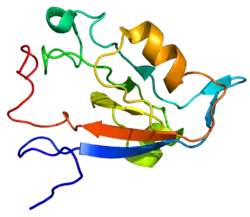TAX1BP3
Tax1-binding protein 3 is a protein that in humans is encoded by the TAX1BP3 gene.[5][6][7] This name is in reference to the Tax1 protein of the Human T-cell Lymphotropic Virus (HTLV) which was used to discover Tax1BP3 in a yeast 2-hybrid screen and subsequently verified by co-IP. TIP1, as it is also known, is a PDZ domain containing protein. However, unlike most PDZ domain proteins which act as scaffolds and often contain multiple PDZ domains as well as other protein domains, TIP1 is essentially just the PDZ domain. This has led to the speculation that TIP1 acts as an inhibitor, either acting to separate PDZ binding motifs from their normal targets or simply preventing the protein to migrate away from the cytosol.
| TAX1BP3 | |||||||||||||||||||||||||||||||||||||||||||||||||||
|---|---|---|---|---|---|---|---|---|---|---|---|---|---|---|---|---|---|---|---|---|---|---|---|---|---|---|---|---|---|---|---|---|---|---|---|---|---|---|---|---|---|---|---|---|---|---|---|---|---|---|---|
 | |||||||||||||||||||||||||||||||||||||||||||||||||||
| |||||||||||||||||||||||||||||||||||||||||||||||||||
| Identifiers | |||||||||||||||||||||||||||||||||||||||||||||||||||
| Aliases | TAX1BP3, TIP-1, TIP1, Tax1 binding protein 3 | ||||||||||||||||||||||||||||||||||||||||||||||||||
| External IDs | OMIM: 616484 MGI: 1923531 HomoloGene: 8749 GeneCards: TAX1BP3 | ||||||||||||||||||||||||||||||||||||||||||||||||||
| |||||||||||||||||||||||||||||||||||||||||||||||||||
| |||||||||||||||||||||||||||||||||||||||||||||||||||
| |||||||||||||||||||||||||||||||||||||||||||||||||||
| |||||||||||||||||||||||||||||||||||||||||||||||||||
| |||||||||||||||||||||||||||||||||||||||||||||||||||
| Wikidata | |||||||||||||||||||||||||||||||||||||||||||||||||||
| |||||||||||||||||||||||||||||||||||||||||||||||||||
References
- GRCh38: Ensembl release 89: ENSG00000213977 - Ensembl, May 2017
- GRCm38: Ensembl release 89: ENSMUSG00000040158 - Ensembl, May 2017
- "Human PubMed Reference:". National Center for Biotechnology Information, U.S. National Library of Medicine.
- "Mouse PubMed Reference:". National Center for Biotechnology Information, U.S. National Library of Medicine.
- Andersson B, Wentland MA, Ricafrente JY, Liu W, Gibbs RA (Jun 1996). "A "double adaptor" method for improved shotgun library construction". Anal Biochem. 236 (1): 107–113. doi:10.1006/abio.1996.0138. PMID 8619474.
- Touchman JW, Anikster Y, Dietrich NL, Maduro VV, McDowell G, Shotelersuk V, Bouffard GG, Beckstrom-Sternberg SM, Gahl WA, Green ED (Mar 2000). "The genomic region encompassing the nephropathic cystinosis gene (CTNS): complete sequencing of a 200-kb segment and discovery of a novel gene within the common cystinosis-causing deletion". Genome Res. 10 (2): 165–173. doi:10.1101/gr.10.2.165. PMC 310836. PMID 10673275.
- "Entrez Gene: TAX1BP3 Tax1 (human T-cell leukemia virus type I) binding protein 3".
Further reading
- Banerjee M, et al. (2012). "Specificity and promiscuity in human glutaminase interacting protein recognition: insight from the binding of the internal and C-terminal motif". Biochemistry. 51 (35): 6950–6960. doi:10.1021/bi3008033. PMC 3433589. PMID 22876914.
- Rousset R, Fabre S, Desbois C, et al. (1998). "The C-terminus of the HTLV-1 Tax oncoprotein mediates interaction with the PDZ domain of cellular proteins". Oncogene. 16 (5): 643–654. doi:10.1038/sj.onc.1201567. PMID 9482110.
- Reynaud C, Fabre S, Jalinot P (2000). "The PDZ protein TIP-1 interacts with the Rho effector rhotekin and is involved in Rho signaling to the serum response element". J. Biol. Chem. 275 (43): 33962–33968. doi:10.1074/jbc.M000465200. PMID 10940294.
- Olalla L, Aledo JC, Bannenberg G, Márquez J (2001). "The C-terminus of human glutaminase L mediates association with PDZ domain-containing proteins". FEBS Lett. 488 (3): 116–122. doi:10.1016/S0014-5793(00)02373-5. PMID 11163757. S2CID 11614189.
- Strausberg RL, Feingold EA, Grouse LH, et al. (2003). "Generation and initial analysis of more than 15,000 full-length human and mouse cDNA sequences". Proc. Natl. Acad. Sci. U.S.A. 99 (26): 16899–16903. Bibcode:2002PNAS...9916899M. doi:10.1073/pnas.242603899. PMC 139241. PMID 12477932.
- Kanamori M, Sandy P, Marzinotto S, et al. (2003). "The PDZ protein tax-interacting protein-1 inhibits beta-catenin transcriptional activity and growth of colorectal cancer cells". J. Biol. Chem. 278 (40): 38758–38764. doi:10.1074/jbc.M306324200. PMID 12874278.
- Twizere JC, Kruys V, Lefèbvre L, et al. (2004). "Interaction of retroviral Tax oncoproteins with tristetraprolin and regulation of tumor necrosis factor-alpha expression". J. Natl. Cancer Inst. 95 (24): 1846–1859. doi:10.1093/jnci/djg118. PMID 14679154.
- Ota T, Suzuki Y, Nishikawa T, et al. (2004). "Complete sequencing and characterization of 21,243 full-length human cDNAs". Nat. Genet. 36 (1): 40–45. doi:10.1038/ng1285. PMID 14702039.
- Gerhard DS, Wagner L, Feingold EA, et al. (2004). "The status, quality, and expansion of the NIH full-length cDNA project: the Mammalian Gene Collection (MGC)". Genome Res. 14 (10B): 2121–2127. doi:10.1101/gr.2596504. PMC 528928. PMID 15489334.
- Hampson L, Li C, Oliver AW, et al. (2005). "The PDZ protein Tip-1 is a gain of function target of the HPV16 E6 oncoprotein". Int. J. Oncol. 25 (5): 1249–1256. doi:10.3892/ijo.25.5.1249. PMID 15492812.
- Alewine C, Olsen O, Wade JB, Welling PA (2007). "TIP-1 has PDZ scaffold antagonist activity". Mol. Biol. Cell. 17 (10): 4200–4211. doi:10.1091/mbc.E06-02-0129. PMC 1635354. PMID 16855024.
This article is issued from Wikipedia. The text is licensed under Creative Commons - Attribution - Sharealike. Additional terms may apply for the media files.



